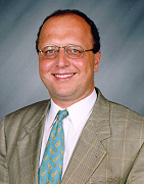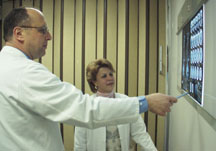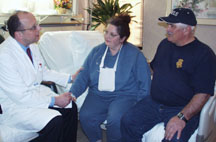 Citing an outdated medical definition of the 1950s and 60s that may prevent thousands at risk for stroke from getting appropriate evaluation and treatment, a group of seven recognized stroke experts, including a UNMC neurologist, have recommended a change of the definition for transient ischemic attack (TIA).
Citing an outdated medical definition of the 1950s and 60s that may prevent thousands at risk for stroke from getting appropriate evaluation and treatment, a group of seven recognized stroke experts, including a UNMC neurologist, have recommended a change of the definition for transient ischemic attack (TIA).
The group has published a consensus statement in the Nov. 21 issue of the New England Journal of Medicine, one of the most prestigious medical journals in the country.
TIA, also referred to as a “mini-stroke” or “minor stroke,” is defined by sudden, temporary stroke-like symptoms with no resulting permanent brain damage. The symptoms last less than 24 hours. Experienced by about 2 million people in the United States annually, TIAs are under-recognized, under-reported and under-treated, and they flag persons at high risk for having a stroke, said Pierre Fayad, M.D., Reynolds Centennial Professor and chairman of the UNMC department of neurological sciences. Dr. Fayad has studied stroke for 14 years and is part of the eight-member group.
|
|
Dr. Fayad said more than 10 percent of people who experience TIAs develop a stroke within the following 90 days, and half of the strokes will happen within 48 hours after the TIA. Dr. Fayad said it’s imperative that patients seek immediate treatment for stroke-like symptoms, even if the symptoms resolve within the first few minutes or hours.
Eliminating the ‘wait & see’ attitude
When the current definition was created, it said TIAs would resolve in 24 hours, even though there was evidence that most would resolve within the first hour, Dr. Fayad said. Other reasons for a redefinition of TIAs are sophisticated medical technology, new drugs and greater knowledge of TIAs and strokes.
 |
Pierre Fayad, M.D., and Vici Sortino, a stroke case manager, look at CT scans and MR angiogram images of patient Cathy Farber. |
Not only has the public been conditioned by the definition to wait and see if stroke-like symptoms resolve within the current defined 24 hours, many health professionals reinforce the idea. Some patients are told to watch their symptoms and asked to come to the emergency room only if their symptoms do not resolve. That’s a lot of time, Dr. Fayad said.
“We are saying most TIAs will resolve within an hour, but even if someone has a TIA, clinically, they may still have stroke resulting in permanent damage to the brain,” Dr. Fayad said. “TIA should be considered exactly like a stroke until proven that it’s not a stroke. Anyone with symptoms should come to the ER. The symptoms of whether it’s a TIA or a stroke should be left up to the physician who evaluates them.”
Taking TIAs seriously
TIA is a serious disease that’s not being taken seriously enough, Dr. Fayad said, not only by physicians and the lay public, but also some insurance companies that refuse to pay for admissions to the hospital after a TIA, because they feel it’s unnecessary. Evaluating people who have had a TIA to find out the cause is crucial, he said.
Sounding off |
TIAs should be treated urgently, Dr. Fayad says in this sound clip. |
Dr. Fayad says symptoms of a stroke warrant a trip to the ER. |
New knowledge and technology have spurred a redefinition of TIAs, Dr. Fayad says. |
“We are much more savvy and now have better tools at preventing and treating stroke,” Dr. Fayad said. “Back then, when the initial definition of TIA was crafted, there was no tissue plasminogen activator (tPA), no magnetic resonance imaging (MRI), no computerized axial tomographic scan (CAT scan) nor magnetic resonance diffusion. In most cases, the only way physicians could evaluate stroke was to examine the patient and at most do an angiogram.
“The advent of MRI diffusion in the last three to four years has added fuel to the debate. We know that over half of patients who have a TIA have changes on their MRI that suggest stroke. MRI diffusion can tell us within minutes where there is a lack of blood flow in the brain. Even for those whose TIAs resolve, it may tell us where that lack of blood flow happened, whereas initially, all physicians had to rely on was what the patient told them.”
Dr. Fayad hopes the consensus statement will trigger a change in attitude of health professionals and the lay public, so people having stroke symptoms or a “brain attack” go to the emergency room as soon as possible and not wait.
A patient’s experience
Cathy Farber, 48, of Tekamah, Neb., experienced a TIA two days before she had a stroke. Farber, who was hospitalized last week at the Nebraska Health System University Hospital, said her symptoms were so brief – less than five minutes — that she didn’t think anything of it.
 |
Pierre Fayad, M.D., left, talks with patient Cathy Farber and her husband, Kerry Farber. |
“I was at work and all of a sudden, I got up from the chair and I felt real tired and I was slurring my words,” said Farber, one of Dr. Fayad’s patients. “It came and went so fast; that’s why I didn’t think anything of it.” It was two days later when after she got out of her bed she couldn’t walk.
“I told my husband something was wrong. I figured what was going on but didn’t want to believe it,” said Farber whose grandmother died from stroke and whose aunt experienced stroke.
Study: TIAs are precursor to stroke
Of the people who have had one or more TIAs, it’s estimated that more than a third will later have a stroke, according to the American Heart Association. Dr. Fayad said in a recent study, researchers found 15 percent of patients who came to the ER with a TIA ended up having a stroke or another TIA within the following several weeks.
A drug approved by the FDA in 1996 – tPA –improves the odds of being cured from stroke by 30 percent if given within three hours from the onset of symptoms. The drug prevents stroke by dissolving clots. Most strokes are due to clots.
“It means the patient has to arrive at the emergency room, at most, within two hours to be able to receive tPA, which doesn’t happen most of the time,” Dr. Fayad said. “This is why tPA is only given in about 2 percent of all patients who have stoke in the nation. You can’t give tPA after three hours because it increases the risk of complications.”
The impact, cause of stroke
It is imperative that patients and doctors not be confused with arbitrary definitions, Dr. Fayad said. “Stroke deprives some people of their independence,” he said. “You can’t shop, can’t visit friends, can’t eat, can’t swallow, can’t see, can’t talk and can’t speak. It essentially deprives us of most of what defines us as human beings.”
In 1999, 167,366 people in the United States died from stroke (one in every 14.3 deaths in the U.S.) according to the American Heart Association. About 47 percent of the deaths occurred outside the hospital. Stroke, the leading cause of death behind diseases of the heart and cancer, also is the leading cause of serious, long-term disability in the United States.
Strokes cause damage to the brain either due to lack of blood flow, either from a clot or leakage of blood into the brain. Most who have strokes are over age 65 and about 20 percent happen in patients under 55, even children. Arteriosclerosis (hardening of the arteries) is one of the main causes of stroke, Dr. Fayad said.